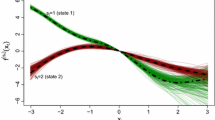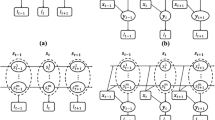Abstract
The execution of price and/or display promotion has a significant effect on the sales of a brand sold in a supermarket. Information on price and/or sales is available from POS data. However, unless an investigator collects information on the execution of display promotions from every retail store, such information is unavailable. This paper presents a method of identifying whether display promotion has been executed without having to visit individual stores. We treat the execution/non-execution of a display promotion as a state variable. An unknown stationary probability matrix is assumed to describe the probability of a transition between states. Each state is characterized by a different stationary time series model with unknown parameters. The objective of the analysis is to identify the model and to assign a probability model for each state at each time instant. Finally, we provide a high precision estimator of a past execution/non-execution of a display promotion based on the proposed model.
Similar content being viewed by others
References
Akaike, H. (1974). “A New Look at the Statistical Model Identification,” IEEE Trans. Autom. Contr., AC-19, 716–723.
Blattberg, Robert C. and Kenneth J. Wisniewski. (1987). “How Retail Price Promotions Work: Empirical Results,” Marketing working paper No. 42, University of Chicago.
Blattberg, Robert C., Gary Eppen, and Joshua Liebermann. (1981). “A Theoretical and Empirical Evaluation of Price Deals in Consumer Non-Durables,” Journal of Marketing, 45, 116–129.
Bucklin, Randolph E. and James M. Lattin. (1991). “A Two-State Model of Purchase Incidence and Brand Choice,” Marketing Science, 10(1), 24–39.
Goldfeld, S. M. and R. E. Quandt. (1973). “A Markov Model for Switching Regression,” Journal of Econometrics, 1, 3–16.
Gordon, K. and A. F. M. Smith. (1988). “Modeling and Monitoring Discontinuous Change in Time Series.” In J. C. Spall (ed.), Bayesian Analysis of Time Series and Dynamic Linear Model. New York: Marcel Dekker, 359–392.
Gordon, K. and A. F. M. Smith. (1990). “Modeling and Monitoring Biomedical Time Series,” Journal of the American Statistical Association, 85, 328–337.
Guadagni, Peter M. and John D. C. Little. (1983). “A Logit Model of Brand Choice Calibrated on Scanner Data,” Marketing Science, 2, 203–238.
Gupta, Sunil. (1988). “Impact of Sales Promotions on When, What, and How Much to Buy,” Journal of Marketing Research, 25.
Hamilton, J. D. A. (1989). “New Approach to the Economic Analysis of Nonstationary Time Series and Business Cycle,” Econometrica, 57, 357–384.
Harrison, P. J. and C. F. Stevens. (1976). “Bayesian Forecasting (with Discussion),” Journal of Royal Statistical Society Ser. B, 38, 205–247.
Higuchi, T. and G. Kitagawa. (2000). “Knowledge Discovery and Self-Organizing State Space Model,” IEICE Transactions on Information and Systems, E83-D(1), 36–43.
Kim, Chang-Jin and Charles R. Nelson. (1999). State Space Models with Regime Switching. Cambridge, MA: The MIT Press.
Kitagawa, G. (1987). “Non-Gaussian State-Space Modeling of Nonstationary Time Series,” Journal of the American Statistical Association, 82, 1032–1063.
Kitagawa, G. and W. Gersch. (1985). “A Smoothness Priors Time Varying AR Coefficient Modeling of Nonstationary Time Series,” IEEE Trans. on Automatic Control, AC-30, 303–314.
Kitagawa, G. and W. Gersch. (1996). Smoothness Priors Analysis of Time Series, Lecture Notes in Statistics, Vol. 116. New York: Springer.
McCullagh, P. and J. A. Nelder. (1989). Generalized Linear models, 2nd edition. London: Chapman and Hall.
Montgomery, Davit. (1971). “Consumer Characteristics Associated with Dealing: An Empirical Example,” Journal of Marketing Research, 4, 118–120.
Neslin, Scott. (2002). Sales Promotion. Cambridge, MA: Marketing Science Institute.
Neslin, Scott, Caroline Henderson, and John Quelch. (1985). “Coupon Promotions and Acceleration of Product Purchase,” Marketing Science, 4.
Pena, D. and I. Guttman. (1988). “Bayesian Approach to Robustifying the Kalman Filter.” In J. C. Spall (ed.), Bayesian Analysis of Time Series and Dynamic Linear Model. New York: Marcel Dekker, 227–254.
Quandt, R. E. (1972). “A New Approach to Estimating Switching Regressions,” Journal of the American Statistical Association, 67, 306–310.
Schwarz, G. (1978). “Estimating the Dimension of a Model,” Annals of Statistics, 6, 461–464.
Tajima, Y. (ed.). (1989). In-Store Merchandising [in Japanese]. Tokyo: Bussiness-sha.
West, Mike and Jeff Harrison. (1997). Bayesian Forecasting and Dynamic Models, 2nd edition. New York: Springer.
Wittink, Dick R., Michael J. Addona, William J. Hawkes, and John C. Porter. (1987). “SCANPRO: A Model to Measure Short-Term Effects of Promotional Activities on Brand Sales, Based on Store-Level Scanner Data,” working paper, Johnson Graduate School of Management, Cornell University, Ithaca, NY.
Yee, V. P. and S. Haykin. (2001). Regularized Radial Basis Function Networks. Wiley Inter-Science.
Author information
Authors and Affiliations
Corresponding author
Rights and permissions
About this article
Cite this article
Sato, T., Higuchi, T. & Kitagawa, G. Statistical Inference Using Stochastic Switching Models for the Discrimination of Unobserved Display Promotion from POS Data. Marketing Letters 15, 37–60 (2004). https://doi.org/10.1023/B:MARK.0000021969.52674.03
Issue Date:
DOI: https://doi.org/10.1023/B:MARK.0000021969.52674.03




